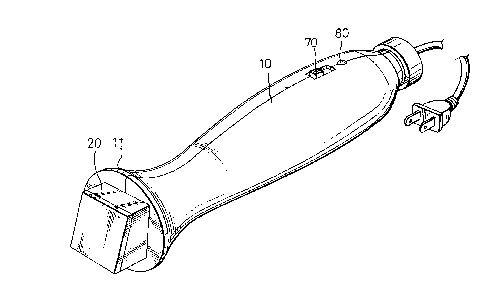Une partie des informations de ce site Web a été fournie par des sources externes. Le gouvernement du Canada n'assume aucune responsabilité concernant la précision, l'actualité ou la fiabilité des informations fournies par les sources externes. Les utilisateurs qui désirent employer cette information devraient consulter directement la source des informations. Le contenu fourni par les sources externes n'est pas assujetti aux exigences sur les langues officielles, la protection des renseignements personnels et l'accessibilité.
L'apparition de différences dans le texte et l'image des Revendications et de l'Abrégé dépend du moment auquel le document est publié. Les textes des Revendications et de l'Abrégé sont affichés :
| (12) Brevet: | (11) CA 2200035 |
|---|---|
| (54) Titre français: | CRAYON CHAUFFANT POUR ESTAMPAGE A L'OR ET SOUDAGE THERMIQUE |
| (54) Titre anglais: | ELECTRIC HEAT PEN FOR GOLD-BLOCKING AND HEAT SEALING PURPOSES |
| Statut: | Périmé et au-delà du délai pour l’annulation |
| (51) Classification internationale des brevets (CIB): |
|
|---|---|
| (72) Inventeurs : |
|
| (73) Titulaires : |
|
| (71) Demandeurs : |
|
| (74) Agent: | SMART & BIGGAR LP |
| (74) Co-agent: | |
| (45) Délivré: | 2000-05-30 |
| (22) Date de dépôt: | 1997-03-14 |
| (41) Mise à la disponibilité du public: | 1998-09-14 |
| Requête d'examen: | 1997-03-14 |
| Licence disponible: | S.O. |
| Cédé au domaine public: | S.O. |
| (25) Langue des documents déposés: | Anglais |
| Traité de coopération en matière de brevets (PCT): | Non |
|---|
| (30) Données de priorité de la demande: | S.O. |
|---|
Crayon chauffant électrique comprenant une base pour le crayon adaptée à la prise de la main, une tête fixée à une extrémité de la base et retenant une plaque chauffante à l'extérieur, deux conducteurs de plaque et un élément chauffant électrique situé entre les conducteurs de plaque à l'intérieur et un commutateur contrôlé pour raccorder l'alimentation d'énergie électrique à l'élément chauffant électrique par les conducteurs de plaque, permettant à l'élément chauffant électrique de produire de la chaleur pour chauffer la plaque chauffante pour un estampage à l'or ou un soudage thermique.
An electric heat pen including a pen base adapted for
the holding of the hand, a pen head fixedly mounted on one
end of the pen base and holding a hot plate on the outside,
two plate conductors and an electric heating element between
the plate conductors on the inside, and a switch controlled
to connect electric power supply to the electric heating
element through the plate conductors, causing the electric
heating element to produce heat for heating said hot plate
for golf-blocking or heat sealing.
Note : Les revendications sont présentées dans la langue officielle dans laquelle elles ont été soumises.
Note : Les descriptions sont présentées dans la langue officielle dans laquelle elles ont été soumises.

2024-08-01 : Dans le cadre de la transition vers les Brevets de nouvelle génération (BNG), la base de données sur les brevets canadiens (BDBC) contient désormais un Historique d'événement plus détaillé, qui reproduit le Journal des événements de notre nouvelle solution interne.
Veuillez noter que les événements débutant par « Inactive : » se réfèrent à des événements qui ne sont plus utilisés dans notre nouvelle solution interne.
Pour une meilleure compréhension de l'état de la demande ou brevet qui figure sur cette page, la rubrique Mise en garde , et les descriptions de Brevet , Historique d'événement , Taxes périodiques et Historique des paiements devraient être consultées.
| Description | Date |
|---|---|
| Inactive : CIB de MCD | 2006-03-12 |
| Inactive : CIB de MCD | 2006-03-12 |
| Inactive : CIB de MCD | 2006-03-12 |
| Inactive : CIB de MCD | 2006-03-12 |
| Le délai pour l'annulation est expiré | 2002-03-14 |
| Lettre envoyée | 2001-03-14 |
| Accordé par délivrance | 2000-05-30 |
| Inactive : Page couverture publiée | 2000-05-29 |
| Préoctroi | 2000-03-07 |
| Inactive : Taxe finale reçue | 2000-03-07 |
| Inactive : Pages reçues à l'acceptation | 2000-02-22 |
| Lettre envoyée | 2000-01-26 |
| Un avis d'acceptation est envoyé | 2000-01-26 |
| Un avis d'acceptation est envoyé | 2000-01-26 |
| Inactive : Approuvée aux fins d'acceptation (AFA) | 2000-01-11 |
| Demande publiée (accessible au public) | 1998-09-14 |
| Inactive : CIB en 1re position | 1997-07-21 |
| Inactive : CIB attribuée | 1997-07-21 |
| Inactive : CIB attribuée | 1997-07-21 |
| Exigences pour une requête d'examen - jugée conforme | 1997-03-14 |
| Toutes les exigences pour l'examen - jugée conforme | 1997-03-14 |
Il n'y a pas d'historique d'abandonnement
Le dernier paiement a été reçu le 2000-02-15
Avis : Si le paiement en totalité n'a pas été reçu au plus tard à la date indiquée, une taxe supplémentaire peut être imposée, soit une des taxes suivantes :
Les taxes sur les brevets sont ajustées au 1er janvier de chaque année. Les montants ci-dessus sont les montants actuels s'ils sont reçus au plus tard le 31 décembre de l'année en cours.
Veuillez vous référer à la page web des
taxes sur les brevets
de l'OPIC pour voir tous les montants actuels des taxes.
| Type de taxes | Anniversaire | Échéance | Date payée |
|---|---|---|---|
| Requête d'examen - petite | 1997-03-14 | ||
| Taxe pour le dépôt - petite | 1997-03-14 | ||
| TM (demande, 2e anniv.) - petite | 02 | 1999-03-15 | 1998-11-27 |
| TM (demande, 3e anniv.) - petite | 03 | 2000-03-14 | 2000-02-15 |
| Taxe finale - petite | 2000-03-07 |
Les titulaires actuels et antérieures au dossier sont affichés en ordre alphabétique.
| Titulaires actuels au dossier |
|---|
| AMMY CHOU |
| Titulaires antérieures au dossier |
|---|
| S.O. |